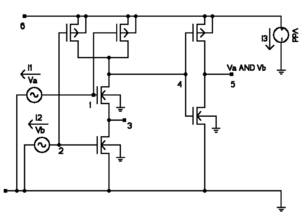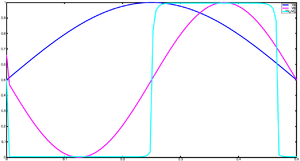Ocs package: Difference between revisions
| Line 31: | Line 31: | ||
* Resistors: | * Resistors: | ||
Rname n+ n- rvalue | Rname n+ n- rvalue | ||
* Voltage sources: | * Voltage sources: | ||
Vname n+ n- <dcvalue> <transvalue> | Vname n+ n- <dcvalue> <transvalue> | ||
** Transvalue specifies a transient voltage source | ** Transvalue specifies a transient voltage source | ||
SIN(VO VA FREQ TD THETA) | SIN(VO VA FREQ TD THETA) | ||
Revision as of 06:53, 22 September 2015
OCS : Octave Circuit Simulator
History and Motivation
Problem Formulation
Data Structure
File Formats
There are several ways of setting up the data structure for an OCS simulation. The first approach is to just assign the fields of the data structure via Octave commands, otherwise one can parse an ascii file written in (a subste of) SPICE netlist language or in OCS's own netlist specification language called IFF (Interchange File Format)
IFF netlists
SPICE netlists
SPICE .spc netlists are parsed via the function "prs_spice", which currently supports the following set of "Element Cards" (after each "Element Card" the instantiating syntax is described)
- Capacitors:
Cname n+ n- cvalue
- Diodes:
Cname anode knode modelname <parameters>
- MOS:
Mname gnode dnode snode bnode modelname <parameters>
N.B.: one instance of a MOS element MUST be preceeded (anywhere in the file) by the declaration of the related model. For instance:
.MODEL mynmos NMOS( k=1e-4 Vth=0.1 rd=1e6)
M2 Vgate 0 Vdrain 0 mynmos
- Resistors:
Rname n+ n- rvalue
- Voltage sources:
Vname n+ n- <dcvalue> <transvalue>
- Transvalue specifies a transient voltage source
SIN(VO VA FREQ TD THETA)
- where:
- VO (offset)
- VA (amplitude)
- FREQ (frequency)
- TD (delay)
- THETA (damping factor)
- The signal produced is
- for time 0 to TD:
- where:
V0
- for time TD to TSTOP:
VO + VA*exp(-(time-TD)*THETA)*sine(twopi*FREQ*(time+TD))
Currently the damping factor has no effect.
Pulse
PULSE(V1 V2 TD TR TF PW PER)
parameters meaning
* V1 (initial value)
* V2 (pulsed value)
* TD (delay time)
* TR (rise time)
* TF (fall time)
* PW (pulse width)
* PER (period)
Currently rise and fall time are not implemented yet.
- .MODEL cards Defines a model for semiconductor devices
.MODEL MNAME TYPE(PNAME1=PVAL1 PNAME2=PVAL2 ... )
TYPE can be:
* NMOS N-channel MOSFET model
* PMOS P-channel MOSFET model
* D diode model
The parameter "LEVEL" is currently assigned to the field
"section" in the call of the element functions by the solver.
Currently supported values for the parameter LEVEL for NMOS
and PMOS are:
* simple
* lincap
(see documentation of function Mdiode).
Currently supported values for the parameter LEVEL for D are:
* simple
(see documentation of functions Mnmosfet and Mpmosfet).
Tutorials
A CMOS AND GATE
Here we show how to set up the simulation of the CMOS AND gate in the figure. The circuit has
- 9 Elements
- 6 MOSFETs (3 n-type + 3 p-type)
- 3 Voltage sources
For the n-type MOSFETs we use a very simple algebraic model defined by the following code
| Code: Model evaluator file for simple MOSFET models |
function [a,b,c] = Mnmosfet (string, parameters, parameternames, extvar, intvar, t)
switch string
case 'simple',
rd = 1e6;
for ii=1:length(parameternames)
eval([parameternames{ii} "=",...
num2str(parameters(ii)) " ;"])
endfor
vg = extvar(1);
vs = extvar(2);
vd = extvar(3);
vb = extvar(4);
vgs = vg-vs;
vds = vd-vs;
if (vgs < Vth)
gm = 0;
gd = 1/rd;
id = vds*gd;
elseif ((vgs-Vth)>=(vds))&(vds>=0)
id = k*((vgs-Vth)*vds-(vds^2)/2)+vds/rd;
gm = k*vds;
gd = k*(vgs-Vth-vds)+1/rd;
elseif ((vgs-Vth)>=(vds))&(vds<0)
gm = 0;
gd = 1/rd;
id = vds*gd;
else # (i.e. if 0 <= vgs-vth <= vds)
id = k*(vgs-Vth)^2/2+vds/rd;
gm = k*(vgs-Vth);
gd = 1/rd;
endif
a = zeros(4);
b = [ 0 0 0 0;
-gm (gm+gd) -gd 0;
gm -(gm+gd) gd 0;
0 0 0 0];
c = [0 -id id 0]';
break;
otherwise
error(["Mnmosfet: unknown option " string]);
endswitch
endfunction
|
The model for the p-type devices is entirely analogous.
Below we show three methods for constructing the circuit data structure
Once the circuit data structure is loaded the simulation can be started by the following commands
| Code: Run the AND gate simulation |
x = [.5 .5 .33 .66 .5 1 0 0 1 ]';
t = linspace (0, .5, 100);
pltvars = {"Va", "Vb", "Va_and_b"};
dmp = .2;
tol = 1e-15;
maxit = 100;
out = tst_backward_euler (outstruct, x, t, tol, maxit, pltvars);
|
Click on the figure to the right to see the simulation results
Build the AND GATE structure directly
| Code: Build the AND GATE structure via an Octave script |
## NLC
# n-type
outstruct.NLC(1).func = "Mnmosfet";
outstruct.NLC(1).section = "simple";
outstruct.NLC(1).nextvar = 4;
outstruct.NLC(1).npar = 3;
outstruct.NLC(1).nparnames = 3;
outstruct.NLC(1).parnames = { "k", "Vth", "rd"};
outstruct.NLC(1).pvmatrix = [1.0000e-04 1.0000e-01 1.0000e+07
1.0000e-04 1.0000e-01 1.0000e+07
1.0000e-04 1.0000e-01 1.0000e+07];
outstruct.NLC(1).vnmatrix = [1 3 4 0
2 0 3 0
4 0 5 0];
outstruct.NLC(1).nintvar = [0 0 0];
outstruct.NLC(1).osintvar = [0 0 0];
# p-type
outstruct.NLC(2).func = "Mpmosfet";
outstruct.NLC(2).section = "simple";
outstruct.NLC(2).nextvar = 4;
outstruct.NLC(2).npar = 3;
outstruct.NLC(2).nparnames = 3;
outstruct.NLC(2).parnames = { "k", "Vth", "rd"};
outstruct.NLC(2).pvmatrix = [-1.0000e-04 -1.0000e-01 1.0000e+07
-1.0000e-04 -1.0000e-01 1.0000e+07
-1.0000e-04 -1.0000e-01 1.0000e+07];
outstruct.NLC(2).vnmatrix = [ 1 6 4 6
2 6 4 6
4 6 5 6];
outstruct.NLC(2).nintvar = [0 0 0];
outstruct.NLC(2).osintvar = [0 0 0];
# Va and Vb
outstruct.NLC(3).func = "Mvoltagesources";
outstruct.NLC(3).section = "sinwave";
outstruct.NLC(3).nextvar = 2;
outstruct.NLC(3).npar = 4;
outstruct.NLC(3).nparnames = 4;
outstruct.NLC(3).parnames = {"Ampl", "f", "delay", "shift"};
outstruct.NLC(3).pvmatrix = [0.50000 1.00000 0.00000 0.50000
0.50000 2.00000 0.25000 0.50000];
outstruct.NLC(3).vnmatrix = [ 1 0
2 0];
outstruct.NLC(3).nintvar = [1 1];
outstruct.NLC(3).osintvar = [0 0];
## LCR
# Vdd
outstruct.LCR(1).func = "Mvoltagesources";
outstruct.LCR(1).section = "DC";
outstruct.LCR(1).nextvar = 2;
outstruct.LCR(1).npar = 1;
outstruct.LCR(1).nparnames = 1;
outstruct.LCR(1).parnames = {"V"};
outstruct.LCR(1).pvmatrix = 1;
outstruct.LCR(1).vnmatrix = [6 0];
outstruct.LCR(1).nintvar = 1;
outstruct.LCR(1).osintvar = 2;
##
outstruct.namesn = [1 2 5 6 7 8 9];
outstruct.namess = {"Va", "Vb", "Va_and_b", "Vdd", "I1", "I2", "I3"};
outstruct.totextvar = 6;
outstruct.totintvar = 3;
|
Build the AND gate circuit structure parsing an IFF netlist
To parse an IFF format netlist of the CMOS AND gate we can use the following command
| Code: Load the AND circuit structure parsing an IFF netlist |
outstruct = prs_iff ("and");
|
The IFF netlist consists of the .cir file named "and.cir" shown below
| Code: IFF netlist for the AND gate (.cir file) |
% 0.1b1
% A Simple CMOS AND GATE
%
% N-Mosfets
% There are 3 N-Mosfets
Mnmosfet simple 4 3
3 3
k Vth rd
1e-4 0.1 1e7
1e-4 0.1 1e7
1e-4 0.1 1e7
1 3 4 0
2 0 3 0
4 0 5 0
%
% P-Mosfets
Mpmosfet simple 4 3
3 3
k Vth rd
-1e-4 -0.1 1e7
-1e-4 -0.1 1e7
-1e-4 -0.1 1e7
1 6 4 6
2 6 4 6
4 6 5 6
%
% Input voltage sources
Mvoltagesources sinwave 2 4
2 4
Ampl f delay shift
0.5 1 0.0 0.5
0.5 2 0.25 0.5
1 0
2 0
END
%
% Power supply
Mvoltagesources DC 2 1
1 1
V
1
6 0
END
|
and of the .nms file named "and.nms shown below
| Code: IFF netlist for the AND gate (.nms file) |
% 0.1b1
1 Va
2 Vb
5 Va_and_b
6 Vdd
7 I1
8 I2
9 I3
|
Build the AND gate circuit structure parsing a .spc file
| Code: Load the AND circuit structure parsing a .spc file |
outstruct = prs_spice ("and");
|
| Code: The .spc file for the CMOS AND gate |
* AND (simple Algebraic MOS-FET model)
.MODEL mynmos NMOS(LEVEL=simple k=2.94e-05 Vth=0.08 rd=.957e7)
.MODEL mypmos PMOS( k=-2.94e-05 Vth=-0.08 rd=.957e7)
M1 Va 3 4 0 mynmos
M2 Vb 0 3 0 mynmos
* nside of the inverter
M3 4 0 Va_and_b 0 mynmos
M4 Va Vdd 4 Vdd mypmos
M5 Vb Vdd 4 Vdd mypmos
* pside of the inverter
M6 4 Vdd Va_and_b Vdd mypmos
V1 Va 0 SIN(0.5 0.5 1 0 0)
V2 Vb 0 SIN(0.5 0.5 2 0.25 0)
V3 Vdd 0 1
.END
|

